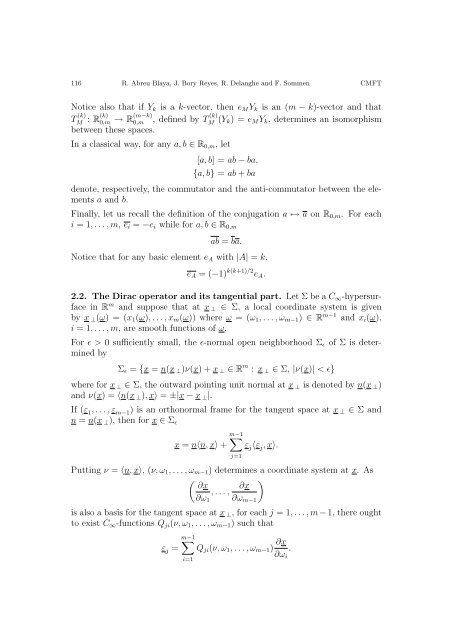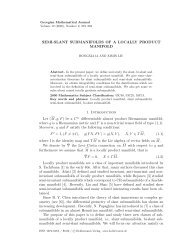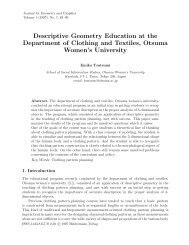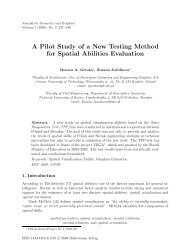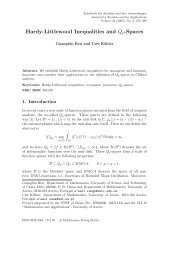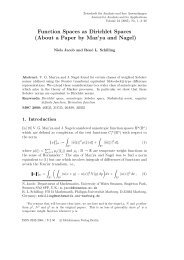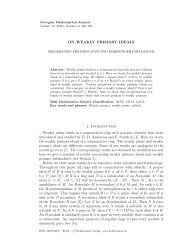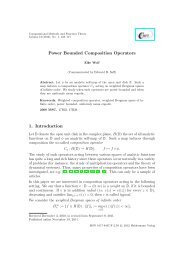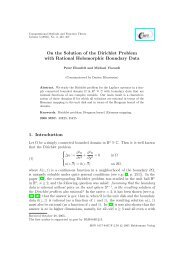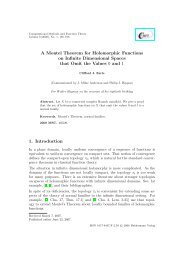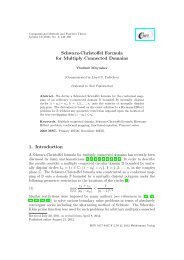Cauchy Integral Decomposition of Multi-Vector Valued Functions on ...
Cauchy Integral Decomposition of Multi-Vector Valued Functions on ...
Cauchy Integral Decomposition of Multi-Vector Valued Functions on ...
Create successful ePaper yourself
Turn your PDF publications into a flip-book with our unique Google optimized e-Paper software.
116 R. Abreu Blaya, J. Bory Reyes, R. Delanghe and F. Sommen CMFT<br />
Notice also that if Y k is a k-vector, then e M Y k is an (m − k)-vector and that<br />
T (k)<br />
M<br />
: R(k) 0,m → R (m−k)<br />
0,m , defined by T (k)<br />
M (Y k) = e M Y k , determines an isomorphism<br />
between these spaces.<br />
In a classical way, for any a, b ∈ R 0,m , let<br />
[a, b] = ab − ba,<br />
{a, b} = ab + ba<br />
denote, respectively, the commutator and the anti-commutator between the elements<br />
a and b.<br />
Finally, let us recall the definiti<strong>on</strong> <str<strong>on</strong>g>of</str<strong>on</strong>g> the c<strong>on</strong>jugati<strong>on</strong> a ↦→ a <strong>on</strong> R 0,m . For each<br />
i = 1, . . . , m, e i = −e i while for a, b ∈ R 0,m<br />
ab = ba.<br />
Notice that for any basic element e A with |A| = k,<br />
e A = (−1) k(k+1)/2 e A .<br />
2.2. The Dirac operator and its tangential part. Let Σ be a C ∞ -hypersurface<br />
in R m and suppose that at x ⊥ ∈ Σ, a local coordinate system is given<br />
by x ⊥ (ω) = (x 1 (ω), . . . , x m (ω)) where ω = (ω 1 , . . . , ω m−1 ) ∈ R m−1 and x i (ω),<br />
i = 1, . . . , m, are smooth functi<strong>on</strong>s <str<strong>on</strong>g>of</str<strong>on</strong>g> ω.<br />
For ɛ > 0 sufficiently small, the ɛ-normal open neighborhood Σ ɛ <str<strong>on</strong>g>of</str<strong>on</strong>g> Σ is determined<br />
by<br />
Σ ɛ = {x = n(x ⊥ )ν(x) + x ⊥ ∈ R m : x ⊥ ∈ Σ, |ν(x)| < ɛ}<br />
where for x ⊥ ∈ Σ, the outward pointing unit normal at x ⊥ is denoted by n(x ⊥ )<br />
and ν(x) = 〈n(x ⊥ ), x〉 = ±|x − x ⊥ |.<br />
If (ε 1 , . . . , ε m−1 ) is an orth<strong>on</strong>ormal frame for the tangent space at x ⊥ ∈ Σ and<br />
n = n(x ⊥ ), then for x ∈ Σ ɛ<br />
x = n〈n, x〉 +<br />
m−1<br />
∑<br />
j=1<br />
ε j 〈ε j , x〉.<br />
Putting ν = 〈n, x〉, (ν, ω 1 , . . . , ω m−1 ) determines a coordinate system at x. As<br />
( )<br />
∂x ∂x<br />
, . . . ,<br />
∂ω 1 ∂ω m−1<br />
is also a basis for the tangent space at x ⊥ , for each j = 1, . . . , m − 1, there ought<br />
to exist C ∞ -functi<strong>on</strong>s Q ji (ν, ω 1 , . . . , ω m−1 ) such that<br />
ε j =<br />
m−1<br />
∑<br />
i=1<br />
Q ji (ν, ω 1 , . . . , ω m−1 ) ∂x<br />
∂ω i<br />
.


